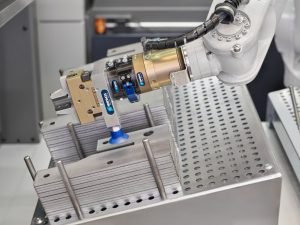One of the biggest challenges fabricators constantly face is chasing the bottlenecks in the metal fabrication process chain. At the center of this process chain is the capacity of the laser cutting machine to process orders and its effect on both upstream and downstream processes.
If you have legacy CO2 laser cutting equipment, you have probably figured it out by now. However, this is not the case with fiber laser cutting equipment due to the ever-increasing fiber laser powers that seemingly change yearly. With these power increases, new challenges arise in the laser cutter’s upstream and downstream processes. Can the front office, engineering, and programming deliver enough volume of programmed parts not to starve out the fiber laser as it processes vast amounts of material? Can the material automation maintain the pace? What about downstream processes like bending?
Front-End Processes
In recent years, equipment manufacturers have pushed to address these ever-changing challenges to the fabrication chain. Realizing the higher volume produced by the fiber laser, they began to innovate new, faster ways to create programs, move materials more efficiently, and create faster bending equipment to maintain the pace.
Bottlenecks were initially found at the front end of the metal fabrication process, with engineering, programming, and material handling. Fabricators realized that software and automation systems needed to be improved to take advantage of fiber laser cutting volumes. Forward-looking and innovative equipment manufacturers foresaw these challenges and were ready with software and automation solutions.
The Shifting Bottleneck
At the front end, equipment manufacturers now create software systems to process incoming orders more efficiently through the ERP system and generate the bill of materials (BOM), material requirements planning (MRP), and with a manufacturing execution system (MES) that processes routing, programming, and scheduling. Material solutions include automated material storage and retrieval systems for raw materials and loading, unloading, and part sorting solutions.
Now, the bottleneck has shifted. The bottleneck has now moved to the press brake and bending operations, though this is not the first time. The difference between then and now is that with CO2 lasers you could just throw additional brakes at the problem. Labor was not as challenging as it is today.
Fast forward to today: A fiber laser can produce 4 to 5 times more volume than a CO2 laser, and you can’t just throw press brakes at the bottleneck. It would be cost-prohibitive, not to mention there is not enough skilled labor to operate the number of press brakes required to handle the high volume. So, you must automate the bending process.
Bending Efficiency
From adding hydraulic clamping and quick-change tooling to offline programming, operational bending efficiency has taken major strides in reducing bottlenecks. When these efficiencies were added, and there was still a need to increase throughput, fabricators added more press brakes. This was in the late CO2 and early fiber days when CO2 laser power was maxing out at 6kW, and fiber laser power was in the low 2kW range. However, as fiber laser powers increased, the immediate challenge for fabricators was keeping the fiber laser from starving, either by insufficient programs in the que or not moving the material efficiently.
Increasing Bending Throughput
When high-speed electric and servo-hydraulic brakes entered the market, they could make twice as many bends per hour as conventional press brakes. However, this was a temporary fix as increased part volumes from higher fiber laser powers exacerbated the bending capabilities.
Fabricators began to realize that smaller brakes could bend the majority of parts faster. To maintain the pace of production, they added mobile bending automation and ran these units on off-shifts and weekends. Offline programming of these cells is easy, and they no longer require robot teach-ins. A four-bend program that used to take hours to create and set up now required only minutes to accomplish for these automated brakes.
For larger bending cells with fixed automation, creating short-run programs at the press brake has been cost-prohibitive due to long programming and setup times. However, this has also undergone major changes. Now, it takes about ten minutes to program a four-bend program. Once at the bending cell, operators can adjust to Z-heights and back gauge positions and quickly step through the program before running in fully automated modes.
Automated Bending Cells
Innovations in fiber laser cutting have demanded changes to both the front-end processes that support the laser cutting equipment and downstream processes such as bending, where we see the majority of bottlenecks today. Investing in automated bending systems with offline programming capabilities provides relief to bending operations as these systems can operate on off-shifts and weekends. A single operator can manage multiple automated bending cells, thereby circumventing the problem of finding qualified press brake operators.
By Frank Arteaga, Regional Director Marketing – Americas
Bystronic Inc., Hoffman Estates, IL
Voice.bystronic@bystronic.com

